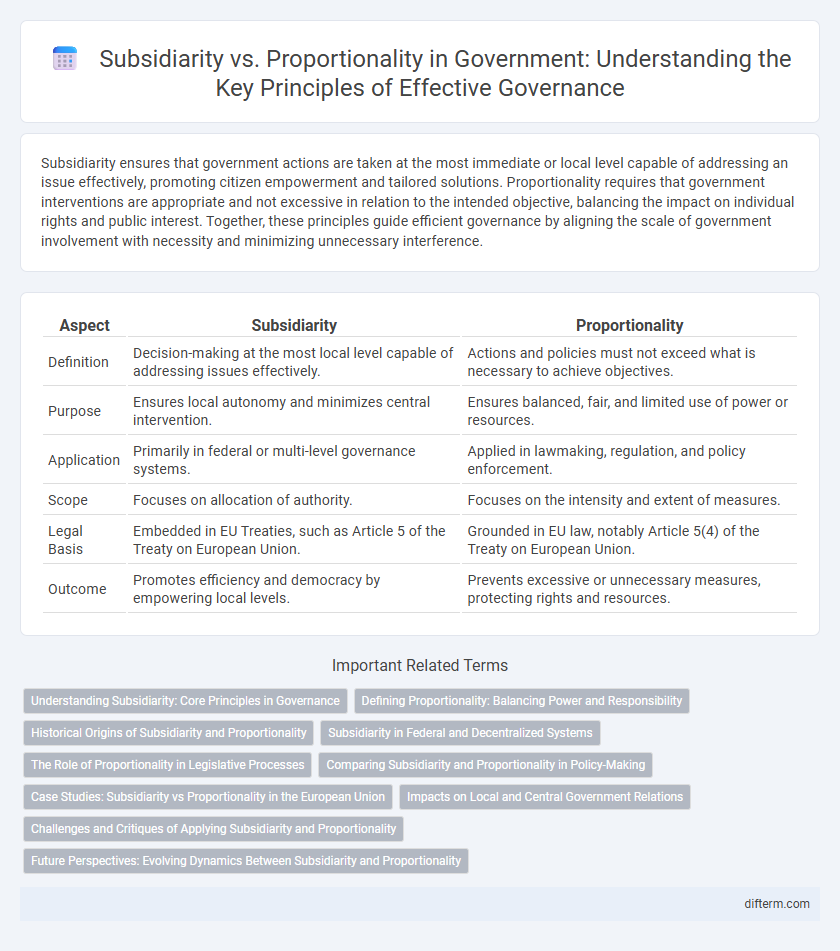Subsidiarity ensures that government actions are taken at the most immediate or local level capable of addressing an issue effectively, promoting citizen empowerment and tailored solutions. Proportionality requires that government interventions are appropriate and not excessive in relation to the intended objective, balancing the impact on individual rights and public interest. Together, these principles guide efficient governance by aligning the scale of government involvement with necessity and minimizing unnecessary interference.
Table of Comparison
| Aspect | Subsidiarity | Proportionality |
|---|---|---|
| Definition | Decision-making at the most local level capable of addressing issues effectively. | Actions and policies must not exceed what is necessary to achieve objectives. |
| Purpose | Ensures local autonomy and minimizes central intervention. | Ensures balanced, fair, and limited use of power or resources. |
| Application | Primarily in federal or multi-level governance systems. | Applied in lawmaking, regulation, and policy enforcement. |
| Scope | Focuses on allocation of authority. | Focuses on the intensity and extent of measures. |
| Legal Basis | Embedded in EU Treaties, such as Article 5 of the Treaty on European Union. | Grounded in EU law, notably Article 5(4) of the Treaty on European Union. |
| Outcome | Promotes efficiency and democracy by empowering local levels. | Prevents excessive or unnecessary measures, protecting rights and resources. |
Understanding Subsidiarity: Core Principles in Governance
Subsidiarity in governance mandates that decisions be made at the most immediate or local level capable of addressing issues effectively, ensuring that higher authorities intervene only when necessary. This principle promotes autonomy, accountability, and responsive administration by empowering local governments to manage their affairs. Understanding subsidiarity clarifies governance structures by balancing centralized oversight with localized decision-making to enhance democratic participation and efficient resource allocation.
Defining Proportionality: Balancing Power and Responsibility
Proportionality in government ensures that actions taken by authorities are appropriately aligned with the scope and severity of the issue, preventing overreach and safeguarding individual rights. It balances power by requiring that measures are suitable, necessary, and the least restrictive to achieve legitimate objectives. This principle complements subsidiarity by maintaining accountability and fairness across different levels of governance.
Historical Origins of Subsidiarity and Proportionality
Subsidiarity originated from Catholic social teaching in the late 19th century, particularly articulated by Pope Pius XI in the 1931 encyclical *Quadragesimo Anno*, advocating that decisions should be made at the most immediate or local level capable of addressing issues effectively. Proportionality, rooted in Roman law and constitutional traditions, emerged as a legal principle to ensure that governmental actions are appropriately balanced and measured in response to the objectives pursued, avoiding excessive or arbitrary measures. Both doctrines have evolved as foundational principles in European Union law, shaping governance frameworks to balance authority between central and subordinate institutions while safeguarding citizens' rights.
Subsidiarity in Federal and Decentralized Systems
Subsidiarity is a core principle in federal and decentralized systems, ensuring that decision-making authority is allocated to the most immediate or local level capable of addressing public issues effectively. This approach enhances governance efficiency, accountability, and citizen participation by empowering regional or local governments to manage their own affairs. It contrasts with centralization, promoting tailored policies that reflect local needs while maintaining cohesion within the broader federal structure.
The Role of Proportionality in Legislative Processes
Proportionality in legislative processes ensures that government measures are appropriate and necessary to achieve policy objectives without excessive restrictions on individual rights. It functions as a key control mechanism for balancing state interests against personal freedoms, requiring laws to be tailored and justified based on their impact. This principle guides lawmakers to adopt measures that are effective yet minimally invasive, fostering fair and equitable governance.
Comparing Subsidiarity and Proportionality in Policy-Making
Subsidiarity and proportionality are fundamental principles guiding policy-making in government, where subsidiarity ensures decisions are made at the most local level possible to enhance efficiency and democratic participation. Proportionality limits government intervention to what is necessary and appropriate to achieve objectives, preventing excessive or arbitrary measures. Comparing these, subsidiarity prioritizes decentralization of authority, while proportionality emphasizes balanced, minimal impact actions within the chosen level of governance.
Case Studies: Subsidiarity vs Proportionality in the European Union
Case studies in the European Union highlight subsidiarity as a principle ensuring decisions are made as closely as possible to citizens, while proportionality limits EU action to what is necessary to achieve objectives. The application of subsidiarity was crucial in reforming the Common Agricultural Policy, where decision-making was decentralized to member states, enhancing regional responsiveness. Proportionality guided competition law enforcement, ensuring regulations did not exceed what was required to maintain market integrity without stifling economic growth.
Impacts on Local and Central Government Relations
Subsidiarity ensures decision-making authority is closest to citizens, empowering local governments to address community-specific needs while reducing central government overreach. Proportionality limits government actions to what is necessary and appropriate, maintaining a balance that prevents excessive interference by central authorities in local matters. Together, these principles shape cooperative dynamics between local and central governments, fostering efficiency, accountability, and respect for regional autonomy.
Challenges and Critiques of Applying Subsidiarity and Proportionality
Challenges in applying subsidiarity involve balancing local autonomy with efficient governance, often complicated by overlapping competencies and unclear jurisdiction boundaries. Proportionality faces critiques related to subjective assessments of necessity and the difficulty in measuring whether governmental actions are appropriately scaled to policy objectives. Both principles encounter implementation hurdles due to political conflicts, inconsistent interpretations, and the complexity of multi-level governance systems.
Future Perspectives: Evolving Dynamics Between Subsidiarity and Proportionality
Future perspectives on subsidiarity and proportionality emphasize their evolving dynamics as governance systems adapt to increasing complexity and digital transformation. Enhanced data-driven decision-making promotes more precise applications of subsidiarity, ensuring decisions occur at the most effective level, while proportionality guides balanced regulatory responses to emerging challenges. These principles will increasingly intersect with AI governance, multi-level policy coordination, and sustainability mandates, fostering agile and accountable government frameworks.
Subsidiarity vs Proportionality Infographic

 difterm.com
difterm.com